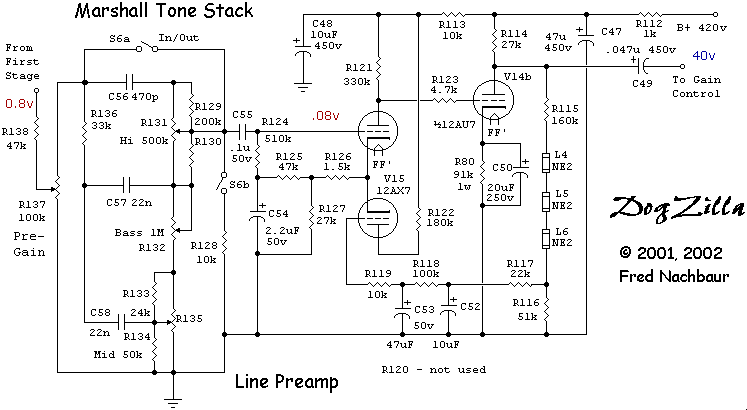
August 20, 2002
Part 8: Marshall Tone Stack / Line Preamp
Do you want to know the secret of guitar amplifier "tone"? It's really quite
simple, tone gurus notwithstanding.
- Have several individual cascaded sections, each of which can be overdriven one at
a time, or in combination, and each with its own tone colour. For this you'll need
individual level controls between stages.
- Supply a good range of tone controls, both of the classic guitar variety and of the
equalizer variety.
- Add a compressor and limiter, and provide for insertion of other effects such as
reverb, echo, etc.
- The added effects in 2: and 3: above will contribute a substantial insertion loss,
requiring additional stages to overcome. See 1: above. ;-)
Line Preamp:
Dogzilla is my implementation of the above ideas. The small-amp emulator circuit
contributes a large insertion loss (about 20 dB), which we have to make up for with yet
another preamp circuit. While we're at it, let's add a "Marshall" tone stack to
give that characteristic sliding mid-range depression. We lose at least another 10 dB here.
So we have to make up for both; another variant on the "universal preamp",
configured as a non-inverting amplifier, accomplishes this quite handily.

Schematic, Marshall Tone Stack and Line Preamp
To give the needed gain, and to add yet another distortion option, this version of the
Universal Preamp is set up for "open loop" operation (no negative feedback). The
open loop voltage gain is about 500 (54 dB).
Marshall Tone Stack:
Tone controls on guitar/instrument amplifiers are an art unto themselves. Unlike the
tone controls typically used on hi-fi gear, which are in general very predictable and
relatively complex, the tone stacks on instrument amps were undoubtedly derived by
"trial and error", using odd-ball topologies and experimenting with different
values until the designer arrived empirically at the desired tone response.
For Dogzilla I chose the classic "Marshall" tone stack. While its range is not
as great as some of the Fender designs, it has a warmth that I personally find pleasing.
(If you want to experiment with various different tone-stack topologies, I can highly
recommend Duncan Munro's
Tone Stack Calculator.)
Since I wanted Dogzilla to be useful also as an amplifier for instruments other than
guitar, facility is provided to bypass the Marshall Tone Stack. The two sections of switch
S6 accomplish this handily, flattening out the response while maintaining approximately
the same signal level. There is still a slight residual effect if the pots are set to
extremes of their range, but in general this effect will go un-noticed.
Note the unusual connection to the Pre-Gain control R137 at the input. This is done
to maintain a relatively high (and relatively constant) impedance to the tone stack,
minimising the effect of the Pre-Gain control on the response curves. (Purists may point
out that in the Marshall, the tone stack was driven from a low impedance source. However,
if you play the the circuit in the Tone Stack Calculator, you'll find that using a much
higher impedance source accentuates the resulting curves, giving more control, without
materially changing their shape. It essentially gives "Fender control" with a
"Marshall colour".)
A series resistor R138 on the wiper of the Pre-Gain pot insures that
a high load impedance is seen by the first pre-amp stage. Needless to say, this introduces
another significant insertion loss. No worries, the pentode input stage described in the
next section has plenty of gain to overcome this loss.





